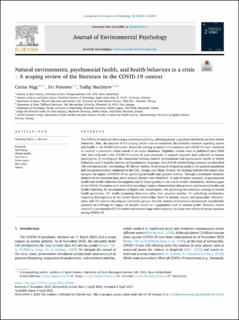| dc.contributor.author | Nigg, Carina | |
| dc.contributor.author | Petersen, Evi | |
| dc.contributor.author | Macintyre, Tadhg | |
| dc.date.accessioned | 2023-05-31T07:52:31Z | |
| dc.date.available | 2023-05-31T07:52:31Z | |
| dc.date.created | 2023-04-14T22:16:27Z | |
| dc.date.issued | 2023 | |
| dc.identifier.citation | Nigg, C., Petersen, E. & MacIntyre, T. (2023). Natural environments, psychosocial health, and health behaviors in a crisis – A scoping review of the literature in the COVID-19 context. Journal of Environmental Psychology, 88, Artikkel 102009. | en_US |
| dc.identifier.issn | 0272-4944 | |
| dc.identifier.uri | https://hdl.handle.net/11250/3069408 | |
| dc.description.abstract | The COVID-19 outbreak led to major restrictions globally, affecting people's psychosocial health and their health behaviors. Thus, the purpose of this scoping review was to summarize the available research regarding nature and health in the COVID-19 context. Keywords relating to natural environments and COVID-19 were combined to conduct a systematic online search in six major databases. Eligibility criteria were a) published since 2020 with data collected in the COVID-19 context b) peer-reviewed, c) original empirical data collected on human participants, d) investigated the association between natural environments and psychosocial health or health behaviors, and e) English, German, or Scandinavian languages. Out of 9126 articles being screened, we identified 188 relevant articles, representing 187 distinct studies. Most research focused on adults in the general population and was predominantly conducted in the USA, Europe, and China. Overall, the findings indicate that nature may mitigate the impact of COVID-19 on psychological health and physical activity. Through a systematic thematic analysis of the extracted data, three primary themes were identified: 1) type of nature assessed, 2) psychosocial health and health behaviors investigated, and 3) heterogeneity in the nature–health relationship. Research gaps in the COVID-19 context were identified regarding I) nature characteristics that promote psychosocial health and health behaviors, II) investigations of digital and virtual nature, III) psychological constructs relating to mental health promotion, IV) health-promoting behaviors other than physical activity, V) underlying mechanisms regarding heterogeneity in the nature–health relationship based on human, nature, and geographic characteristics, and VI) research focusing on vulnerable groups. Overall, natural environments demonstrate considerable potential in buffering the impact of stressful events on a population level on mental health. However, future research is warranted to fill the mentioned research gaps and to examine the long-term effects of nature exposure during COVID-19. | en_US |
| dc.language.iso | eng | en_US |
| dc.rights | Navngivelse 4.0 Internasjonal | * |
| dc.rights.uri | http://creativecommons.org/licenses/by/4.0/deed.no | * |
| dc.title | Natural environments, psychosocial health, and health behaviors in a crisis – A scoping review of the literature in the COVID-19 context | en_US |
| dc.type | Peer reviewed | en_US |
| dc.type | Journal article | en_US |
| dc.description.version | publishedVersion | en_US |
| dc.rights.holder | © 2023 The Authors. | en_US |
| dc.source.volume | 88 | en_US |
| dc.source.journal | Journal of Environmental Psychology | en_US |
| dc.identifier.doi | https://doi.org/10.1016/j.jenvp.2023.102009 | |
| dc.identifier.cristin | 2140966 | |
| dc.source.articlenumber | 102009 | en_US |
| cristin.ispublished | true | |
| cristin.fulltext | original | |
| cristin.fulltext | original | |
| cristin.qualitycode | 2 | |

